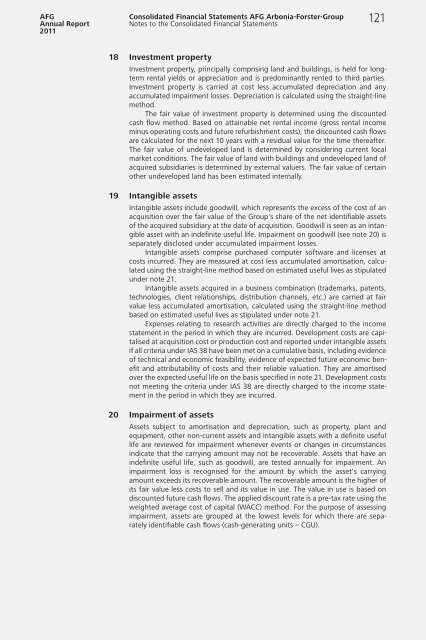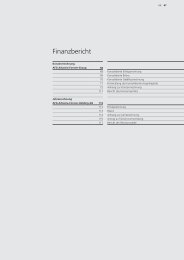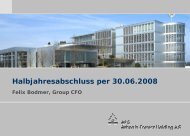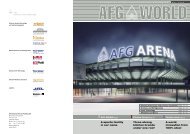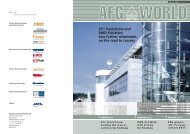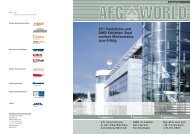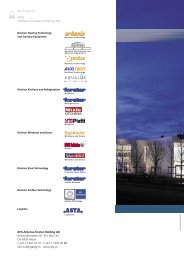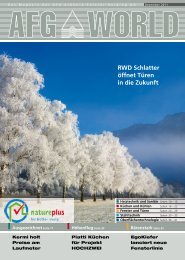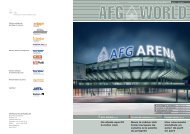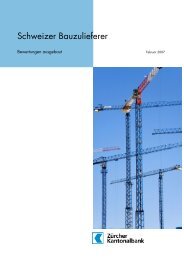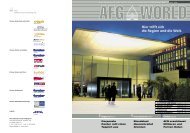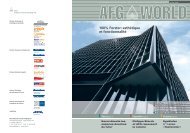Financial Report
Financial Report
Financial Report
Create successful ePaper yourself
Turn your PDF publications into a flip-book with our unique Google optimized e-Paper software.
AFG<br />
Annual <strong>Report</strong><br />
2011<br />
Consolidated <strong>Financial</strong> Statements AFG Arbonia-Forster-Group<br />
Notes to the Consolidated <strong>Financial</strong> Statements<br />
18 Investment property<br />
121<br />
Investment property, principally comprising land and buildings, is held for longterm<br />
rental yields or appreciation and is predominantly rented to third parties.<br />
Investment property is carried at cost less accumulated depreciation and any<br />
accumulated impairment losses. Depreciation is calculated using the straight-line<br />
method.<br />
The fair value of investment property is determined using the discounted<br />
cash flow method. Based on attainable net rental income (gross rental income<br />
minus operating costs and future refurbishment costs), the discounted cash flows<br />
are calculated for the next 10 years with a residual value for the time thereafter.<br />
The fair value of undeveloped land is determined by considering current local<br />
market conditions. The fair value of land with buildings and undeveloped land of<br />
acquired subsidiaries is determined by external valuers. The fair value of certain<br />
other undeveloped land has been estimated internally.<br />
19 Intangible assets<br />
Intangible assets include goodwill, which represents the excess of the cost of an<br />
acquisition over the fair value of the Group's share of the net identifiable assets<br />
of the acquired subsidiary at the date of acquisition. Goodwill is seen as an intangible<br />
asset with an indefinite useful life. Impairment on goodwill (see note 20) is<br />
separately disclosed under accumulated impairment losses.<br />
Intangible assets comprise purchased computer software and licenses at<br />
costs incurred. They are measured at cost less accumulated amortisation, calculated<br />
using the straight-line method based on estimated useful lives as stipulated<br />
under note 21.<br />
Intangible assets acquired in a business combination (trademarks, patents,<br />
technologies, client relationships, distribution channels, etc.) are carried at fair<br />
value less accumulated amortisation, calculated using the straight-line method<br />
based on estimated useful lives as stipulated under note 21.<br />
Expenses relating to research activities are directly charged to the income<br />
statement in the period in which they are incurred. Development costs are capitalised<br />
at acquisition cost or production cost and reported under intangible assets<br />
if all criteria under IAS 38 have been met on a cumulative basis, including evidence<br />
of technical and economic feasibility, evidence of expected future economic benefit<br />
and attributability of costs and their reliable valuation. They are amortised<br />
over the expected useful life on the basis specified in note 21. Development costs<br />
not meeting the criteria under IAS 38 are directly charged to the income statement<br />
in the period in which they are incurred.<br />
20 Impairment of assets<br />
Assets subject to amortisation and depreciation, such as property, plant and<br />
equipment, other non-current assets and intangible assets with a definite useful<br />
life are reviewed for impairment whenever events or changes in circumstances<br />
indicate that the carrying amount may not be recoverable. Assets that have an<br />
indefinite useful life, such as goodwill, are tested annually for impairment. An<br />
impairment loss is recognised for the amount by which the asset's carrying<br />
amount exceeds its recoverable amount. The recoverable amount is the higher of<br />
its fair value less costs to sell and its value in use. The value in use is based on<br />
discounted future cash flows. The applied discount rate is a pre-tax rate using the<br />
weighted average cost of capital (WACC) method. For the purpose of assessing<br />
impairment, assets are grouped at the lowest levels for which there are separately<br />
identifiable cash flows (cash-generating units – CGU).


